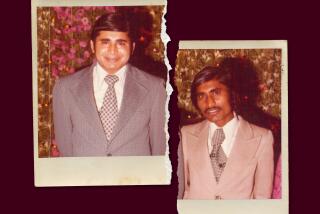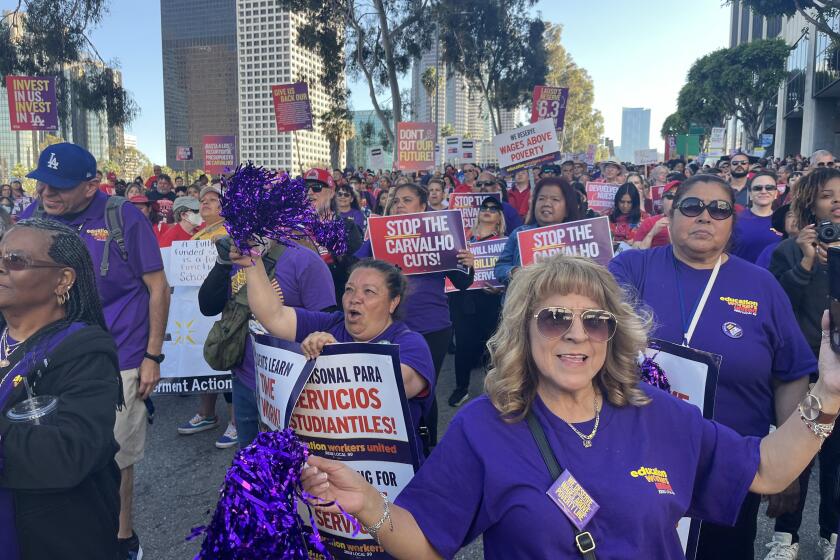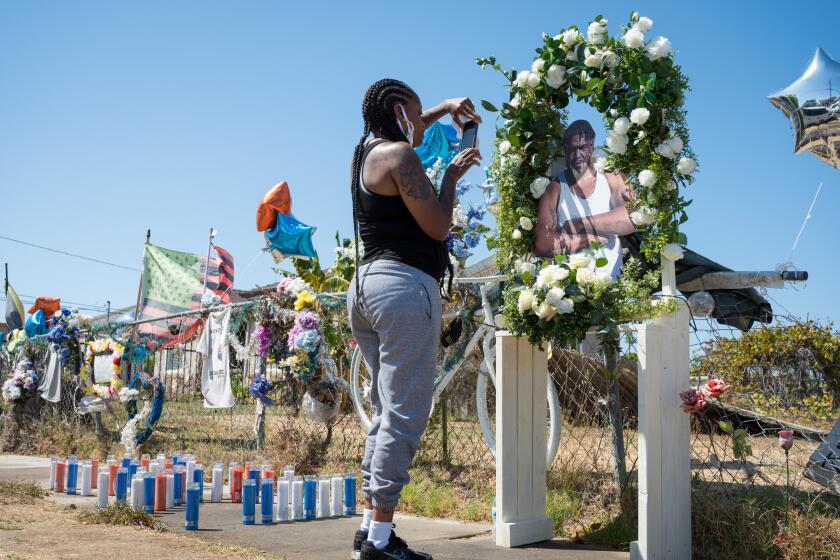Attorney Cast as Both Slaying Mastermind, Biker Friends’ Victim
He usually came to court in a rumpled black suit, carrying a tattered briefcase crammed with papers. With his long, unruly hair, attorney Thomas F. Maniscalco stood out in an Orange County courtroom.
Now, he arrives in a yellow Orange County Jail jump suit, accused of masterminding the slayings of three people in Westminster almost eight years ago.
Maniscalco, 43, and Daniel M. Duffy, 44, compatriots in the Hessians motorcycle club, face possible death sentences for the 1980 Memorial Day weekend triple slaying of a fellow Hessian and his girlfriend and bodyguard.
8-Year Delay
Four years of police investigation preceded their arrests, and legal delays have consumed another four years. The case was stayed again two weeks ago by the 4th District Court of Appeal in Santa Ana over pretrial issues. Prosecutors and lawyers for Maniscalco, who will face trial first, hope to learn this week whether a trial date can be set immediately.
The trials promise to produce tales of revenge, drug deals, counterfeiting schemes and family strife--all part of a drug subculture festering in the midst of a group of middle-class tract neighborhoods in Westminster.
“What must the neighbors think when they learn about all
this?” one law-enforcement official pondered.
Maniscalco is depicted by prosecutors as the brainy leader of a band of scoundrels fiercely loyal to him at the time of the killings. “Tom’s got charisma,” one of them told police.
But the defense lawyers paint Maniscalco as a self-styled, counterculture attorney for society’s outcasts--a victim of his own house guests who have made him the scapegoat to cover up their own crime.
“Tom’s weakness is he’s a sucker for a hard-luck story,” said one of his lawyers, Joanne Harrold. “So he takes these people into his home to help them out, when he barely knows them.”
Triple Slaying Victims
The victims in the triple slaying were Richard (Rabbit) Rizzone, 35, a longtime member of the Hessians; Thomas Monahan, 28, and Rena Arlene Miley, a 19-year-old police officer’s daughter who became Rizzone’s girlfriend just a few weeks before her death.
Their bodies were found June 8, 1980, more than a week after the shootings, at the house Rizzone had rented in Westminster. Rizzone, found in a closet, and Monahan, in the living room, had been shot twice each. Miley, found nude in her bed, had been shot three times in the head.
Prosecutors claim in court papers that Rizzone was the target of the attack.
“There’s absolutely no doubt that the other two were killed simply because they were witnesses,” said Deputy Dist. Atty. Anthony J. Rackauckas Jr. “That means these people would have killed anyone. A kid selling cookies at the door would have been murdered.”
It was not until October, 1981, a year and a half later, that Maniscalco and Duffy became key suspects.
Michigan officials had discovered a member of a local motorcycle club in Lansing, called the Family, riding a Harley-Davidson with a false registration. It was Rizzone’s. The motorcycle was traced to Robert Robbins, who told police when he was questioned that he had been hiding in the woods of northern Michigan for more than a year.
Robbins, after first denying that he knew anything, eventually admitted to police that he had stolen the motorcycle and had participated in the Westminster triple murder. The trigger man, he said, was Phil Warren, a 26-year-old fellow Family member. But the mastermind, Robbins said, was Maniscalco. Duffy was also a participant, he told police.
Robbins, who has now testified before two grand juries and at two preliminary hearings, told this story:
Dealing Drugs
He and “Little Phil” Warren were dealing drugs in Michigan, and Duffy, while living in California, was involved in some of the transactions. When Warren drifted to Southern California, Robbins followed. They lived with Maniscalco and his wife, Cricket, along with Warren’s girlfriend, Tracy Luett, and Bruce Van Arsdell. Warren was the son of Hessians co-founder Ray Carini, a close friend of Maniscalco.
Robbins claims Maniscalco was dealing drugs, selling counterfeit money and planning to kill Rizzone, who had cheated him on a deal involving either drugs or counterfeiting. One day, Robbins said, the pink slip for Rizzone’s motorcycle arrived in the mail from the Department of Motor Vehicles because Rizzone was using the lawyer’s house as a mail drop. Maniscalco allegedly asked Robbins to get Michigan registration papers for the motorcycle.
On May 31, 1980, Robbins says, Duffy and Warren left the Maniscalco house together. Later, Robbins said, he left with Maniscalco for Rizzone’s house in a van belonging to Al Stokes, an acquaintance.
Duffy and Warren already were there when they arrived, Robbins said, and Rizzone was dead in a closet. Duffy and Maniscalco began searching through drawers, Robbins said, and Duffy told him to put the Michigan plates on Rizzone’s motorcycle.
Later, Robbins said, he passed “Fat Tommy” Monahan, Rizzone’s bodyguard, heading toward the house. Robbins said he that when he returned to the house he found Monahan dead and Warren standing over him with the gun. Robbins said he heard Miley in a back bedroom crying and turned down Warren’s offer that Robbins have sex with her. Robbins said he learned later that she had been killed.
‘Nothing to Worry About’
The most chilling line in the prosecution’s case comes from Robbins, quoting Duffy: “If Phil (Warren) took care of the girl, then we’ve got nothing to worry about.”
Robbins said that Maniscalco covered his hand with a rag while searching the house and that Duffy and Warren wore gloves. Robbins said he was instructed to put Band-Aids on his fingers to avoid leaving fingerprints.
Two days later, Robbins said, he and Warren returned to Michigan in Al Stokes’ van, with Rizzone’s motorcycle in the back. Stokes was found slain a month later.
Shortly after Robbins was first interviewed by police, Richard Dean Munt, a Laguna Beach man with a long criminal record, was arrested in connection with a counterfeiting scheme. When police questioned him, Munt talked about Maniscalco, saying he knew the lawyer had initiated a plan to poison someone a few weeks before the triple murder.
Munt also gave police information about a gun with a silencer that later was traced to the triple slaying.
Plan for Poisoning
Robbins also had talked about a plan by Maniscalco to poison Rizzone.
Dozens of other people were interviewed in the next few years in an attempt to corroborate Robbins’ story and to track down the murder weapon.
But Warren, for one, could not be interviewed. Nine months after Robbins talked to the police, Warren was killed by two police officers in Moore, Okla., after he attacked them with a knife.
Then, in February, 1984, police found Van Arsdell, a Maniscalco house guest at the time of the killings. He had joined the Marine Corps.
Van Arsdell’s version of the events at the Maniscalco house on May 31, 1980, corroborated much of what Robbins had to say. Maniscalco and Duffy were arrested three weeks later.
Van Arsdell said he remembers Maniscalco talking, a few weeks before the killings, about the motorcycle, saying Rizzone would not need it after “he has his accident.”
Admitted Roles
Prosecutors say they will produce other witnesses who will testify that Maniscalco and Duffy both admitted their roles in the murders.
According to grand jury testimony, prosecutors have identified the gun used in the triple killing. Ballistics tests show it was the same gun that was confiscated later in Los Angeles County in a case involving an illegal weapons sale.
And prosecutors say they have witnesses who can testify that the gun--which was destroyed after the prosecution in Los Angeles--was at Maniscalco’s house at the time of the triple killing.
Defense lawyers argue that the prosecution’s entire case is built on the testimony of admitted criminals.
They point to several gaping holes in Robbins’ story. For example, he disavows being near the young woman who was killed. But he admits he had bandages on his fingers, and a bandage wrapper was found on the floor near the body. Also, they contend, Robbins says he was conveniently outside the house each time one of the victims was shot.
Harrold contends that Warren, Robbins and Van Arsdell were the killers.
“These people in that house were not loyal to Tom Maniscalco--it was Phil Warren,” she said.
Defense Says ‘No Motive’
The defense also complains that prosecutors can show no motive--that Rizzone and Maniscalco were close friends.
Prosecutors answer that they believe Robbins’ story because so many details can be corroborated.
Rackauckas waves aside arguments by defense attorneys that Maniscalco was simply a host and not the leader of the drug users staying with him.
“If I didn’t believe he was responsible for killing those people, I wouldn’t be prosecuting him,” Rackauckas said. “He was definitely the leader in that house.”
Robbins is now living with his wife and two children in another state. He was given a new identity by law enforcement officials, and Rackauckas says he has been a model citizen since he first began talking to police. Van Arsdell is still in the Marines. His testimony in hearings in the case so far fills half a dozen volumes.
At one point, court records show, Van Arsdell explained in part why he was cooperating with investigators:
“It could have bothered me less if they killed Rabbit (Rizzone), you know. . . . Then in Michigan, when I seen the articles (on the killings), you know, damn, those guys are so sloppy that they kill two innocent people.”
In his testimony, Van Arsdell added: “There is a lot of people dead. For what? Virtually no reward. I don’t see anybody rich.”
More to Read
Start your day right
Sign up for Essential California for news, features and recommendations from the L.A. Times and beyond in your inbox six days a week.
You may occasionally receive promotional content from the Los Angeles Times.






